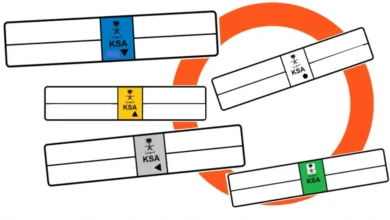Importing Cars from the UAE to Saudi Arabia: A Comprehensive Guide
Many citizens and residents in Saudi Arabia resort to importing their cars from other countries, especially from the UAE, due to the low customs duties and taxes imposed on cars when exporting them. Additionally, the UAE enjoys a wide variety of car brands, ranging from sports and luxury cars to cars with powerful engines. In the following lines, we will provide a comprehensive guide explaining how to import cars safely and easily from the UAE to Saudi Arabia, along with the necessary conditions and procedures for that.
Regulations for Importing Vehicles from the UAE
There are clear and specific regulations set by the Zakat, Tax, and Customs Authority for individuals importing vehicles from the UAE to Saudi Arabia, aimed at organizing the import process and ensuring that vehicles meet the required standards. These regulations include the following:
Regulations for Importing Vehicles Based on Type and Weight
- Small cars, buses, and light transport vehicles: Importing these vehicles is allowed as long as the vehicle model does not exceed 5 years, with age calculated in reverse excluding the current year.
- Heavy transport trucks: Importing heavy transport trucks (over 3.5 tons) is allowed provided their age does not exceed 5 years, calculated from January of the manufacturing year.
Other Regulations
- The vehicle must comply with the Energy Efficiency Certificate, and an inquiry notification must be issued via the website of the “Saudi Standards, Metrology and Quality Organization.”
- Importing historical vehicles that are over 30 years old is allowed, provided the customs card is stamped with “not allowed to operate on public roads.”
- Saudi citizens and holders of premium residency are allowed to import used light vehicles that do not meet energy efficiency and age requirements, with a fee ranging from 20-50% of the vehicle’s value.
- Documents must be verified and match the chassis number registered on the vehicle, ensuring there are no alterations or modifications to the chassis number.
- Residents are allowed to import one private vehicle every three years, and they may not sell it until three years have passed from the date of its import, marked by a stamp on the card indicating this period. It is also prohibited for residents to import transport vehicles and buses.
- As for citizens of the Gulf Cooperation Council (GCC) countries, each GCC citizen is permitted to import two vehicles within 12 months.
Vehicles Banned from Being Imported from the UAE
- Importing historical vehicles that are over 30 years old is prohibited.
- Importing sports vehicles used in racing circuits is prohibited.
- The laws do not apply to new vehicles that do not meet energy efficiency as long as the mileage does not exceed 1000 km and they are from the current or previous year’s models.
- Importing vehicles under a power of attorney is prohibited, as the power of attorney is used only to complete customs procedures.
- Importing vehicles that have been submerged, involved in accidents, fires, overturning, or structural damage, based on inspection results by the Zakat, Tax, and Customs Authority is forbidden. In cases of objection, three reports from accredited sources such as (AUTOCHECK), (CARFAX), or Motor Vehicle Dept must be provided. Importing vehicles that were used as taxis or police cars is prohibited.
- Importing vehicles bearing school transport logos or any similar type is forbidden.
- Importing vehicles that have sustained exterior damage is prohibited unless the damage occurred at the port of arrival, in which case a certificate from the relevant authority must be presented to document it.
- Importing vehicles that have had their steering wheel modified from right to left is prohibited.
- Importing stolen vehicles is forbidden.
- Importing vehicles that have had their chassis numbers tampered with is prohibited.
- Importing transport vehicles belonging to residents is prohibited.
- Importing armored vehicles is forbidden.
Required Documents
The process of importing a vehicle from the UAE to Saudi Arabia requires a set of documents and papers, which include the following:
- A document proving ownership of the vehicle (such as an export certificate for cars imported from Gulf countries like the UAE or equivalent from other countries).
- Residence permit (for residents).
- National ID (for citizens of GCC countries).
- A document indicating the method of payment.
Steps to Import Cars from the UAE to Saudi Arabia
To import a car from the UAE to Saudi Arabia, there are official steps and procedures that must be adhered to, subject to the laws and conditions set by both countries for exporting and receiving cars, which include the following steps:
- Ensure Required Documents are Prepared: It is important to ensure that all necessary documents for importing the vehicle are available, such as the ownership certificate and a valid technical inspection certificate.
- Prepare Vehicle Import Transaction: Those wishing to import a vehicle from the UAE to Saudi Arabia should issue a vehicle export certificate, which can be obtained from service centers affiliated with licensing and traffic in Dubai and Abu Dhabi. These centers include: the website and app of the Roads and Transport Authority in Dubai, customer happiness centers, service centers, contact centers, and the “TAM” site in Abu Dhabi, as well as the official website and app of the UAE Ministry of Foreign Affairs for institutions and companies.
- Obtain Customs Clearance Certificate: A customs clearance certificate must be obtained from UAE customs after submitting the required documents to these authorities.
- Conduct Technical Inspection of the Vehicle: UAE authorities may require a technical inspection of the vehicle at accredited inspection centers such as those under the Roads and Transport Authority in Dubai. The inspection aims to ensure that the vehicle complies with the regulations and conditions required for export.
- Pay Necessary Fees: The required fees to complete the legal procedures for exporting the vehicle must be paid, according to the amounts stipulated on the official state websites.
- Organize Export Process: After preparing the documents and inspecting the vehicle, arrangements should be made with a shipping company to transport the vehicle from the UAE to Saudi Arabia properly (by land, sea, or air).
- Transport the Vehicle to Saudi Arabia: After completing all procedures, the vehicle is transported to Saudi Arabia and must be subjected to inspection by Saudi customs to ensure compliance with local laws, along with providing documents such as the customs clearance certificate.
- Register the Vehicle: After the vehicle reaches the Kingdom, it is registered at the Saudi traffic department, providing the necessary papers for that.
Costs of Importing Cars from the UAE
There are several factors that affect the cost of importing cars from the UAE to the Kingdom of Saudi Arabia, with the most important of these being customs duties. According to Saudi customs regulations, the customs duty imposed on imported cars is approximately 5% of the car’s base value. Additionally, supplementary insurance fees of about 1% of the vehicle’s value are imposed.
In addition to customs duties and insurance, there are other additional costs, such as the fee for obtaining a license plate for the imported vehicle, which is about 160 SAR. These fees also include vehicle registration costs, and a fee of 125 SAR must be paid for a vehicle inspection at the traffic department. Finally, export plates for the vehicle are issued at around 510 SAR, along with the cost of mounting the plates.
Fee Determination Mechanism
The customs value is determined based on the invoice provided by the seller, and if there is any doubt about the invoice, the lists provided by the local agent will be used, which determine the value of the new vehicle with an annual depreciation rate of 10% starting from the first month of each year, beginning in March. The discount for vehicles does not exceed 50% for cars and 80% for trucks.
When a vehicle enters the Gulf Cooperation Council countries, customs fees are calculated according to the following regulations:
- No more than two years should have passed since the vehicle entered the first Gulf port.
- Documents proving the payment of customs duties at the first Gulf port must be provided.
- The value presented from the first port is accepted if the concerned authority is convinced; otherwise, the vehicle is assessed, and any difference in customs duties is collected.
- If the fee category changes, the difference in fees must be paid if the rate is lower at one of the ports.
Fees Based on Engine Capacity
- 1600cc Engine: The customs duty is 40% of the vehicle’s value.
- Engine Above 1600cc and up to 2000cc: The customs duty is 135% of the vehicle’s value.
Advantages and Disadvantages of Importing Cars from the UAE
Pros
- Value for Money: Sometimes, purchasing a car in a different currency can save some money, as cars imported from the UAE are cheaper compared to those sold in Saudi Arabia.
- No Age Restrictions on Vehicles: In the UAE, there are no stringent conditions regarding the age of imported vehicles, allowing cars of varying ages to be imported.
- Flourishing Used Car Market: The market for used cars in the UAE has seen significant growth in recent years, making it easier to sell the imported car there if you wish to sell it later.
Cons
- Difference in Steering Wheel Location: It is essential for the steering wheel to be on the right side of the car to register it in Saudi Arabia, as cars with left-side steering may cause legal hurdles when trying to register them.
- Corrosion of Vehicle Structure: Cars that do not meet Gulf specifications are more susceptible to rust due to the high heat and humidity in Saudi Arabia. In this case, modifications may be required to suit climatic conditions, which could be more expensive than purchasing a car with original Gulf specifications.
- High Customs Duties: Saudi Arabia imposes customs duties of up to 5% of the vehicle’s value upon import, increasing the cost of the imported vehicle and affecting the financial viability of the process.
Important Tips for Importing Cars from the UAE
Here are some important tips to ensure a smooth importing process of a vehicle from the UAE to Saudi Arabia:
- Confirm Compliance with Conditions and Laws: Anyone wishing to import a vehicle from the UAE to Saudi Arabia must ensure that they are abiding by the laws and conditions set by both the UAE and Saudi Arabia. It is advisable to check the official regulations through government channels to facilitate the export and import process.
- Remove Removable Exterior Parts: Ensure all non-permanent parts in the vehicle, such as racks or removable outer parts, are removed to reduce space and ensure safety.
- Inspect the Vehicle Thoroughly: The vehicle must be carefully examined to ensure it is free of any personal belongings and check all parts to ensure there are no damages or unwanted additions.
- Conduct Visual Inspection of the Vehicle: Inspect the vehicle for any scratches or external markings and it is advisable to take photos of the vehicle from all angles to document its condition before shipping.
- Check Tires and Fluids: Ensure to examine the condition of the tires and air pressure, and also check engine oil, brake fluid, and hydraulic fluid.
- Look for Fluid Leaks: Check for any fluid leaks around the engine, fuel tank, or underneath the vehicle, and take necessary actions to repair if found.
- Leave a Small Amount of Fuel: It is recommended to leave a small amount of fuel in the vehicle sufficient for parking during shipping and to start the car upon arrival at the port, planning to go to the nearest gas station upon arrival.
- Securely Close and Lock the Vehicle: Ensure that the vehicle is securely closed and lock the top part if it is convertible to guarantee safety during transport.
- Keep a Spare Key: It is advisable to keep an extra copy of the car’s ignition key in case of travel outside the country or in an emergency situation.
- Retain Copies of Important Documents: Ensure to keep copies of most important documents related to the vehicle, such as vehicle registration, ownership certificate, and any other legal papers.
- Insurance Coverage Against Shipping Risks: If you wish to cover the vehicle against shipping risks, it is advisable to insure the vehicle against any potential damages during transport.
- Coordinate with the Shipping Company: Collaborate with the shipping company regarding the necessary papers for exporting the vehicle or for any tourism export.
- Follow Up on Arrival Date: Stay in touch with the shipping company or the shipping line to determine the vehicle’s arrival date at the port in Saudi Arabia, to avoid any delays in receiving it.






